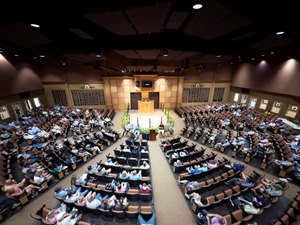CBA Holds Illuminating Veterinary Panel at Fasig-Tipton


For the first time since the Consignors and Commercial Breeders Association has begun holding informational panels on the eve of major horse sales, the organization hosted a veterinary seminar on two major equine studies July 9 at the Fasig-Tipton sale grounds in Lexington.
The two studies, one on stifles and the other on sesamoiditis, each focused on how lucencies in those targeted areas can progress and regress as yearlings evolve into 2-year-olds as well as how they can affect a horse's racing performance.
Led by Dr. Jeffrey Berk, the seminar included researchers Dr. Wayne McIlwraith and Dr. Christopher Kawcak and a veterinary panel that included Dr. Michael Hore, Dr. Scott Hay, Dr. Nathan Mitts, and Dr. Scott Pierce. The panel responded to audience questions upon the conclusion of an overview of both studies.
Every veterinarian on the panel concurred that the information from the studies was pertinent to both buyers and consignors, especially two days prior to the Fasig-Tipton July Sale, where hundreds of yearlings will pass through the ring.
"The CBA has hosted events the past few years but with the publishing of the study from Colorado State University we thought it was very important to spread that information to the industry and what better place to do that at (than Fasig-Tipton) to get everyone together for the first yearling sale of the year," said Rob Tribbet, the vice president of the CBA.
The event featured complimentary drinks and appetizers prior to the seminar. Consignors, buyers, and farm owners alike attended the panel, which was held in Fasig-Tipton's sales pavilion.

"Historically we've done a 'Deal or No Deal' seminar. We started to work on that this year but Fasig-Tipton told us that the Grayson Jockey Club had already contacted them about hosting this panel so we jumped on board and we were happy to organize it," said CBA president Walker Hancock.
"I thought it was a great turnout," Hancock added. "It went fantastic."
The first study, funded by Colorado State University, used digital radiographs to examine three different grades of lucencies in the stifles in yearlings and 2-year-olds. Featuring data collected from the radiographs of 2,508 yearlings and 436 2-year-olds, the study revealed that horses with grade 1 and grade 2 lesions have extremely high probabilities of racing while horses with more serious grade 3 lesions still made the starting gate 79.6% of the time. The study was published in the Equine Veterinary Journal in March of this year.
The second study examined the changes in sesamoiditis from the yearling to 2-year-old stage and how lucencies can affect race performance. There were greater discrepancies found in the results of this study as opposed to the earlier stifle study. Using a 1-3 grading scale and collecting data from 20,000 yearlings and 3,500 2-year-olds, researchers concluded that only 67.2% of horses with severe grade 3 sesamoiditis raced compared with the 85.6% of those that raced with the milder grade 1 sesamoiditis.
With the information obtained from the studies, the vets agreed buyers and consignors should have a lot more clarity and education on both stifle and sesamoiditis before purchasing or selling a horse.
"It's about matching risk tolerance with the science," Dr. Berk said at the conclusion of the panel.
